Hey dear readers! We will explore all the types of brakes or braking systems in detail in this article.
What is a Braking System?
A braking system is a mechanical device that stops motion by absorbing energy from the moving system. It is used to slow or stop a moving vehicle, wheel, or axle, or to prevent motion, which usually happens through friction.
Before applying the brakes, the acceleration is released to stop the fuel supply thus the engine develops more power to drive the vehicle, and then the brakes are applied which causes to stop rotating the wheels, and hence the vehicle is stopped.
The clutch is also disengaged which disconnects the engine from the transmission system. So, when the vehicle is standing, the engine is still running at idle.
Let’s understand the common function of a braking system.
Read Also: A Complete List of Basic Parts of Car Wheel Assembly [PDF]
Functions of the Brakes
There are two distinct functions of the brakes:
- To stop or slow down the vehicle in the shortest possible distance in emergencies.
- Control the vehicle to be maintained when descending a hill.
The first functions call for the brakes which can apply large braking torques to the brake drums, while the second calls for brakes that can dissipate large quantities of the heat without large temperature rises.
Types Braking Systems
Following are the types of braking systems used in vehicles:
#1 Mechanical Braking System
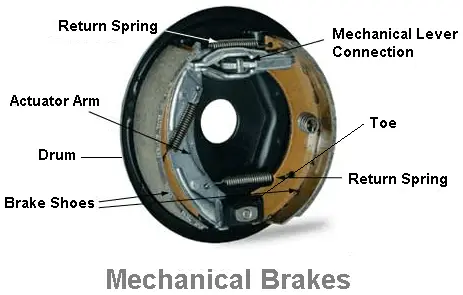
The mechanical braking system causes two surfaces to rub against one another, creating friction. In this braking system, a specific force is applied to the pedal, and it is transferred to the final drum by mechanical parts like a fulcrum, springs, and that are used as linkages to transmit force from one point to another, slowing the vehicle.
Both the surface friction and the force used to apply the brake play a role in how quickly or effectively it slows down.
#2 Hydraulic Braking System
The hydraulic brakes are applied by fluid pressure. The pedal force is transmitted to the brake shoe using a confined liquid through force transmission.
This system is based upon Pascal’s principle, which states that “the confined liquid transmits pressure without loss equally in all directions.” It essentially consists of two main components – the master cylinder and the wheel cylinder.
The master cylinder is connected by tubing to the wheel cylinder on each of the four wheels. This system fills with liquid under light pressure when the brakes are not in operation.
#3 Electric Braking System
Electric brakes are also used for some motor vehicles, although these are not very popular. Warner electric brake is one example of such a brake. These types of braking systems have an electromagnet within the brake drum.
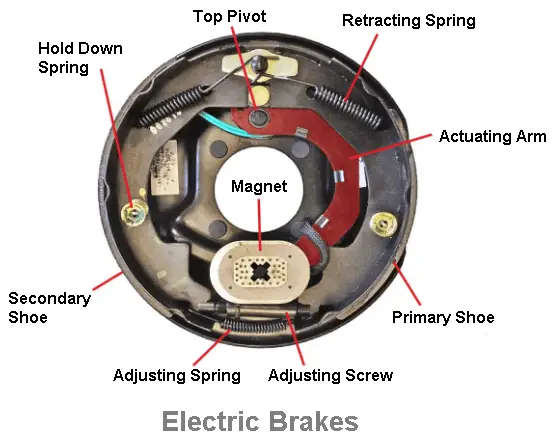
The brake is worked when the current from the battery is used to energize the electromagnet, Which activates the mechanism to extend the brake shoe against the brake drum, and thus brake is applied. The severity of braking is controlled through a rheostat, which is driven by the driver through the foot pedal.
Electric brakes are very simple in construction, they don’t require any complicated operating linkages. It is necessary to take only the current from the battery to the electromagnet. In addition, these are much faster than other types of brakes.
Advantages
- It works more effectively than mechanical braking systems, which must be expensive and frequently replaced.
- Since electric braking does not require such replacement, it is more affordable and effective.
- With the use of electric braking, the system’s speed capacity rises significantly when hauling heavy loads.
- It aids in energy conservation because a small amount of energy returns to the supply, resulting in a significant reduction in operating costs.
#4 Regenerative Braking System
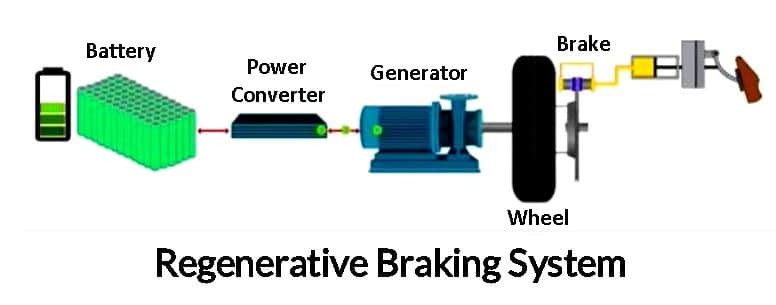
Regenerative braking systems are commonly found in hybrid and electric vehicles. It absorbs kinetic energy from braking and turns it into electrical power for recharging the vehicle’s high-voltage battery. Regenerative braking also slows the car, making traditional brakes more effective.
Advantages
- As a result of less wear and tear, the brake pads last longer.
- Regenerative braking improves battery pack performance, which may reduce anxiety when driving long distances.
- Hybrid vehicles have higher fuel efficiency.
#5 Power-Assisted Brakes
A great braking force is needed to apply the brakes in the case of motor vehicles fitted with disc brakes, as well as for heavy commercial vehicles. Power-assisted brakes are used to equate the limited strength of the driver with the great braking force.
Generally, the entire intake manifold vacuum is used by the power-assisted system. Therefore, they are also known as vacuum brakes.
In this system, when the brake pedal is depressed, fluid is forced from the master cylinder to the primary chamber of the wheel cylinder. Now the intermediate piston provided at the end of the master cylinder also closes the diaphragm valve in the reaction chamber.
This results in isolating the vacuum from the air side of the boost system. The sir control spool is opened to admit air at atmospheric pressure with the movement of the intermediate piston further along its bore.
#6 Vacuum Braking System
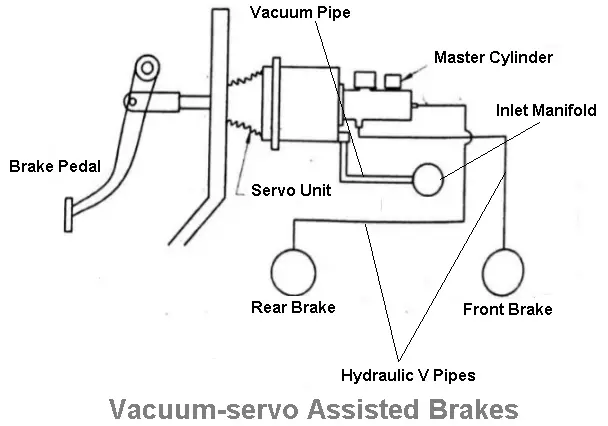
In this system, the partial vacuum existing in the inlet manifold, when the engine is running, provided the power to operate the brakes. The effort provided by the servo system is proportional to the applied power, and it is usually in the ratio of 4:1. A vacuum valve is used to make a vacuum connection from the engine to the vacuum cylinder.
The atmospheric valve remains open and the vacuum valve remains closed when the brakes are not applied. When the brake pedal is depressed, the atmospheric valve opens, the vacuum valve also piston opens and the engine exhausts air inside the servo cylinder.
#7 Electromagnetic Braking System
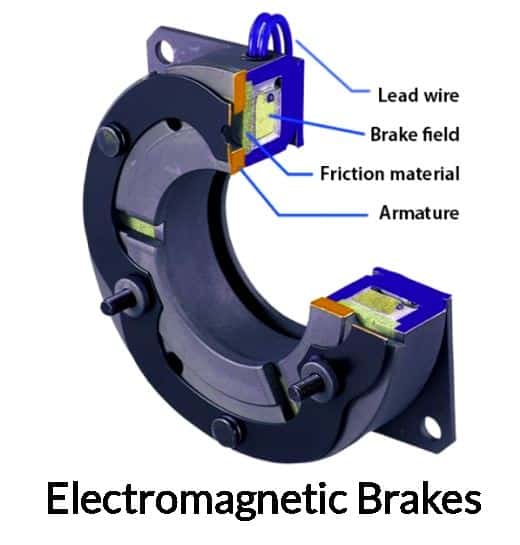
Many modern and hybrid vehicles use electromagnetic braking systems. The electromagnetic braking system achieves frictionless braking by utilizing the electromagnetism principle. This prolongs the life and improves the reliability of brakes.
Likewise, conventional braking systems are prone to slipping, whereas this is supported by quick magnetic brakes. This technology is preferred in hybrids because it reduces friction and eliminates the need for lubrication.
Comparatively speaking, it is much smaller than conventional braking systems. It is primarily utilized in trains and trolleys.
Using electromagnetic brakes, we see rapid current flowing in an opposite direction to the rotating wheel when a magnetic flux passes perpendicular to the rotating direction. This slows down the wheel’s rotation by producing an opposing force.
Advantages
- Electromagnetic braking is quick and affordable.
- There are no maintenance costs associated with electromagnetic brakings, such as replacing brake shoes regularly.
- The capacity of the system can be improved by using electromagnetic braking.
#8 Eddy Current Brake
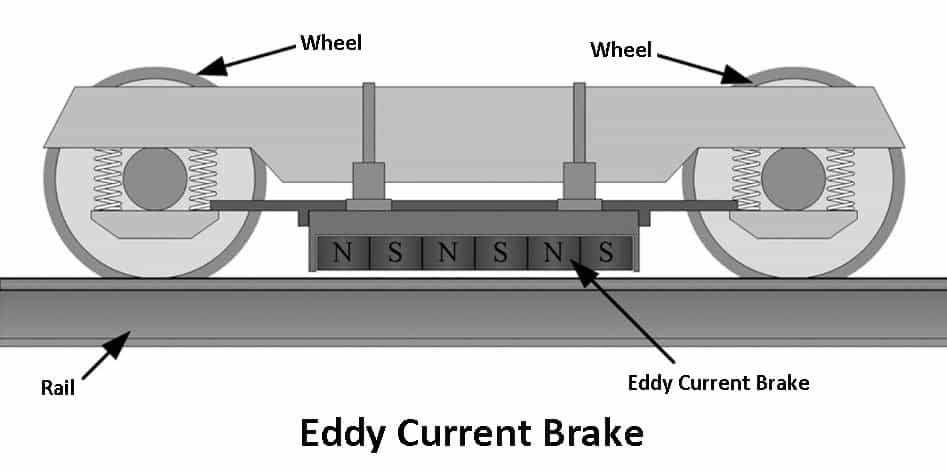
These types of brakes are used to slow down or stop moving objects by creating eddy currents that release the kinetic energy of the object as heat.
The drag force in an eddy current brake is not created by friction between two surfaces pressed together. Instead, the drag force comes from electromagnetic forces between a magnet and a nearby conductive object in motion. This is due to eddy currents induced by electromagnetic induction in the conductor.
The magnetic field in an eddy current brake can be generated by a permanent magnet or an electromagnet. The eddy current brake is used to slow trains and roller coasters, in semi-trailer trucks to prevent brake wear and overheating, in electric meters for electric utilities, and in stoppers for powered tools.
#9 Pneumatic or Air Brakes
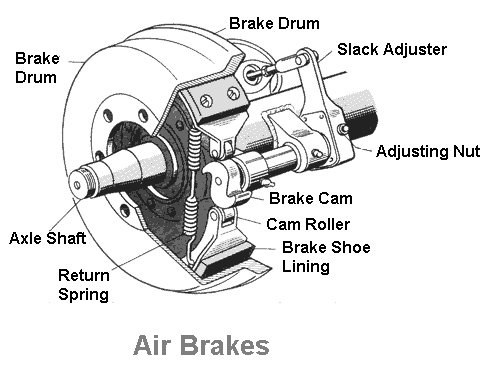
Air brakes are commonly used in heavy vehicles like buses and trucks which require a heavier braking effort that can be applied by the driver’s foot. Working against flexible diaphragms in the brake chamber, air brakes are applied by compressed air pressure rather than foot pressure.
The diaphragms are connected to the brake rod which connects to the brake operating cams on the wheel brakes. These diaphragms are controlled through valves operated by hand or foot.
The brake valve controls brake operation by directing the flow of air from a reservoir against diaphragms in the brake chambers when the brakes are applied, and from the brake chambers to the atmosphere when the brakes are released.
You might like: Basic Parts of Car Wheel Assembly and Its Function
Types of Brakes
#1 Drum Brake
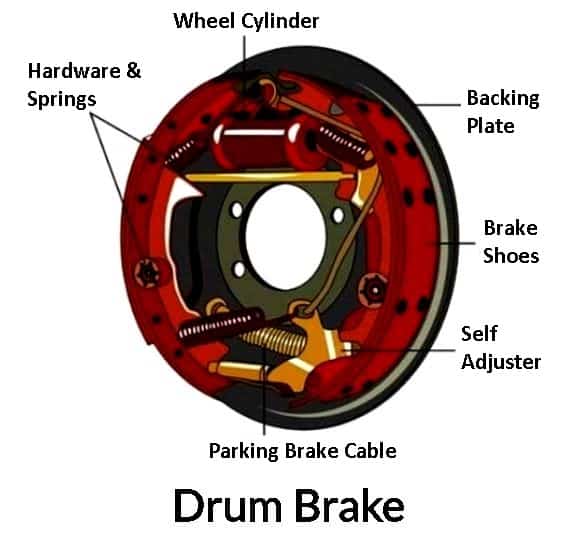
In a motor vehicle, the wheel is attached to an auxiliary wheel called a drum, and brake shoes are made to contact this drum. In most designs, two shoes are used with each drum to form a complete brake mechanism at each wheel. The brake shoes have brake linings on their outer surface.
In these types of brakes, each brake shoe is connected at one end by the anchor pin, the other end is operated by some means so that the brake shoe expands and comes in contact with the brake lining drum.
When the brakes are not applied, the brake shoes are held in position by removing the spring. And also the drum has an entire mechanism to keep out dust and moisture.
Advantages
- It produces less heat because the vehicle’s front brakes produce the majority of the stopping power.
- Compared to disc brakes, it produces or emits less particulate matter.
- Since its frictional contact area is at the circumference, it offers more braking power than a disc brake with an equal diameter.
- In contrast to the disc brake, it required less maintenance to increase corrosion resistance.
- These types of brakes are reliable and affordable.
#2 Disc Brakes
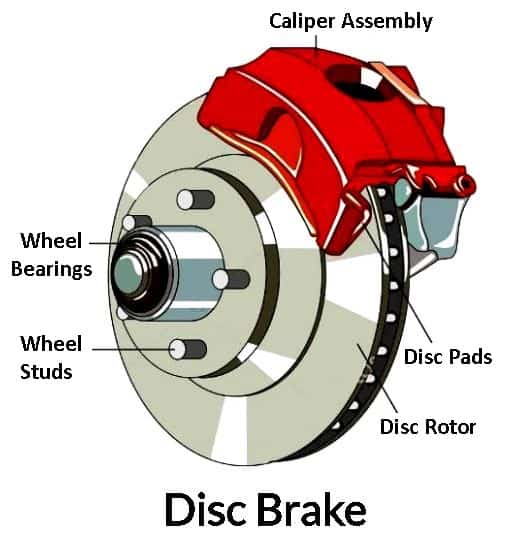
Disc brakes are types of brakes that generate friction by pressing pairs of pads up against a disc or “rotor” using calipers. This kind of process slows the rotation of a shaft, such as an axle on a vehicle, either to slow down the rotation or to hold it still. This motion generates waste heat that needs to be expelled.
The most popular type of disc brake for automobiles is hydraulically actuated, but the principles of a disc brake can be applied to virtually any rotating shaft. A disc brake is composed of a disc, a master cylinder, and a caliper, which consists of both a cylinder and two brake pads.
Advantages
- Disc brakes have greater force-stopping capacity.
- It is more effective to use a shorter stopping distance.
- These types of brakes can clean themselves.
- This brake is lighter and stronger.
You might like: Drum Brake vs. Disc Drake: What’s the Difference?
#3 Emergency Brakes
Foot brakes and hand brakes are also known as parking and emergency brakes.
In most passenger cars, the mechanical brake is operated by hand or foot is used for parking and emergency brakes. These brakes either act on the rear wheels or are attached to the transmission or on the propeller shaft.
The brake lever is mounted under the instrument panel to the left of the driver. When the brake is applied, the lever is locked in place by a ratchet.
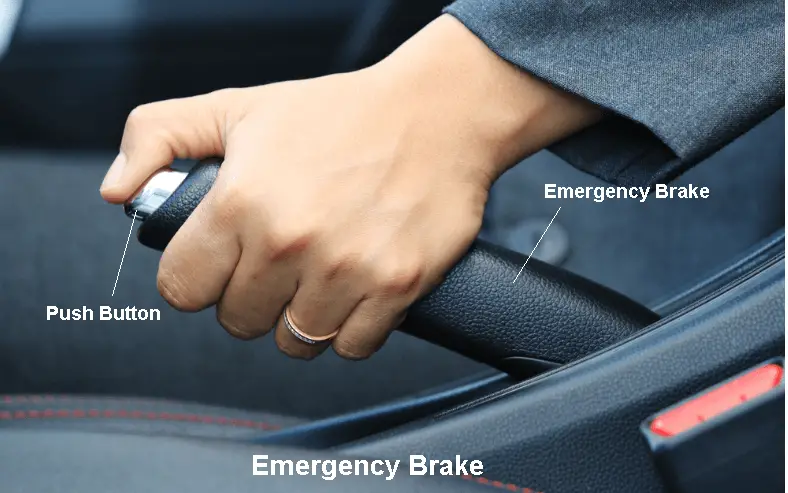
For releasing the brakes, different methods are used. Some hand brakes are released by squeezing the level and control finger together, others are released by turning the lever and pushing it down.
The foot pedal is released by special release levers. In rear-wheel-type parking brakes, a cable or pull rod connects the parking or emergency lever to an idol lever that is mounted on the cross member of the frame.
#4 V-Brakes
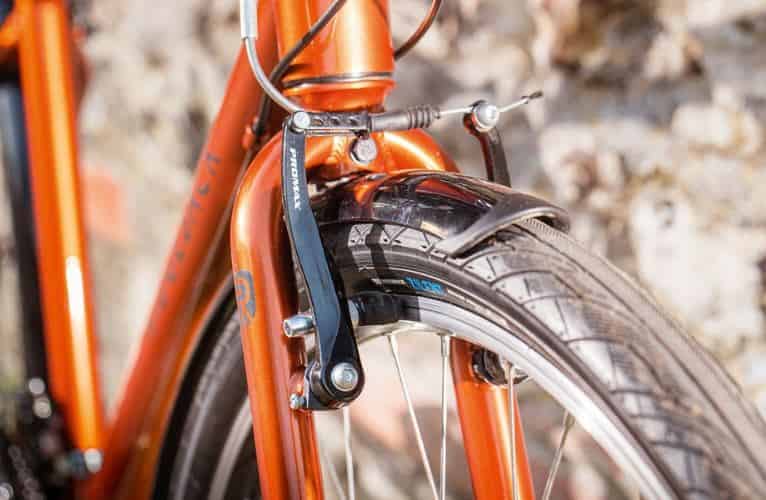
Similar to conventional cantilever brakes, V-brakes operate by bolting their two halves to bosses welded to the frame. They are side-actuated, with the inner cable clamped to one arm and the cable housing secured to the other with a “noodle.” The two arms are drawn together as the cable is pulled through the housing, moving the pads closer to the rim.
When suspensions began to become more common, V-brakes became popular on mountain bikes, eventually displacing traditional cantilever brakes on most models. Almost all mountain bikes now have disc brakes instead of V-brakes, but tough touring bikes still favor them.
V-brakes were not widely adopted for use on cyclocross bikes because they can be unsafe in muddy conditions due to the reduced clearance between the pads and rim and the closeness of the straddle cable and tire.
You might like: What is Manual Transmission? How It Works?
Most Popular Type
#1 Anti-lock Brakes
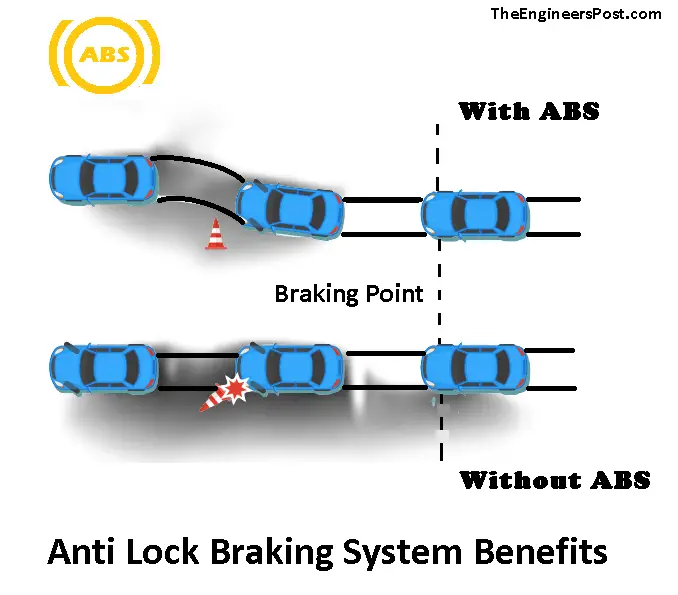
An anti-lock braking system (ABS) is a type of safety anti-skid braking system that is used on buses, trucks, cars, and motorcycles as well as on airplanes. A car with ABS prevents its wheels from locking up while braking, maintains tractive contact with the road, and gives the driver more control.
It uses threshold braking and cadence braking principles that skillful drivers practiced before ABS became widely used.
While ABS generally improves steering control and shortens stopping distances on dry and some slick surfaces, it may lengthen stopping distance significantly on loose gravel or snow-covered surfaces.
Advantages
- With ABS, the rear brakes are enhanced by using anti-skid components to provide improved traction and stability.
- It shortens the distance traveled after applying the brakes.
- ABD lessens skidding and gives you more control over the direction of your car.
- ABS is a more efficient braking system that enhances steering response.
You might like: 20 Types of Cycles & Their Uses [Explained in Details]
Conclusion
That’s it thanks for reading, If you have any questions about “types of brakes and braking systems” you can ask in the comments. If you have liked this article then please share it with your friends.
Subscribe to our newsletter to get notifications of our new posts
Download the PDF file of this article
Read Also:
- Difference Between Internal and External Combustion Engine
- Different Types of Suspension Systems Explained
- Spark Plug: Types, Parts, Working Principle, Requirements
References and External Links:
FAQs
As the brake pedal is depressed, hydraulic wheel cylinders push the curved brake shoes against the rotating brake drum, which has a friction lining. The effect of this contact is friction, which allows the vehicle to slow or stop.
In modern autos, disc brakes are far more common than drum brakes. Disc brakes use a metal disc (or rotor) mounted to each wheel hub. It has two brake pads on either side that push together when the drive depress the brake pedal. As a result, the car slows down.
Hydraulic brakes are the most popular braking system in modern vehicles. It uses hydraulic (fluid) pressure to stop wheels in motion. The system employs two fluid-filled pistons and springs, one positioned above the other.
Please share any info on Electric Cars
Sure, I’ll write about this topic. Make sure to subscribe to our newsletter.
Explain exaust brake and ABS brake system also
Sure’ we’ll do.
I lern a lot these site of information is very useful of learning how breaking system it work..
Thanks for your valuable feedback.
very educative
Thank you very much
Why brakes get heated in both front and back
The main cause of brake overheating is friction. While the working principle of the braking system is based on friction, it increases with an aggressive driving style. This leads to an increase in brake temperature.
Very excellent work
Thanks for reading.